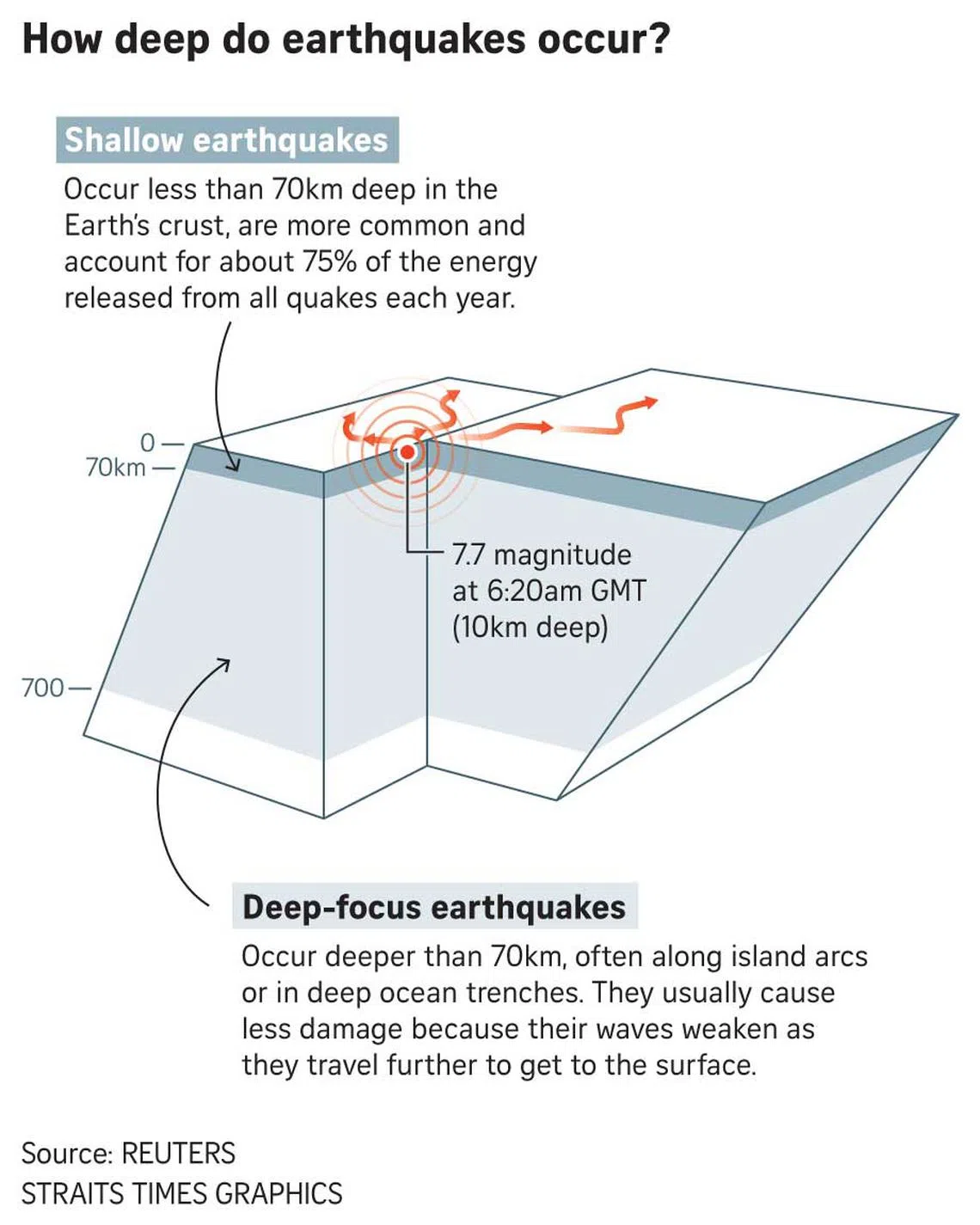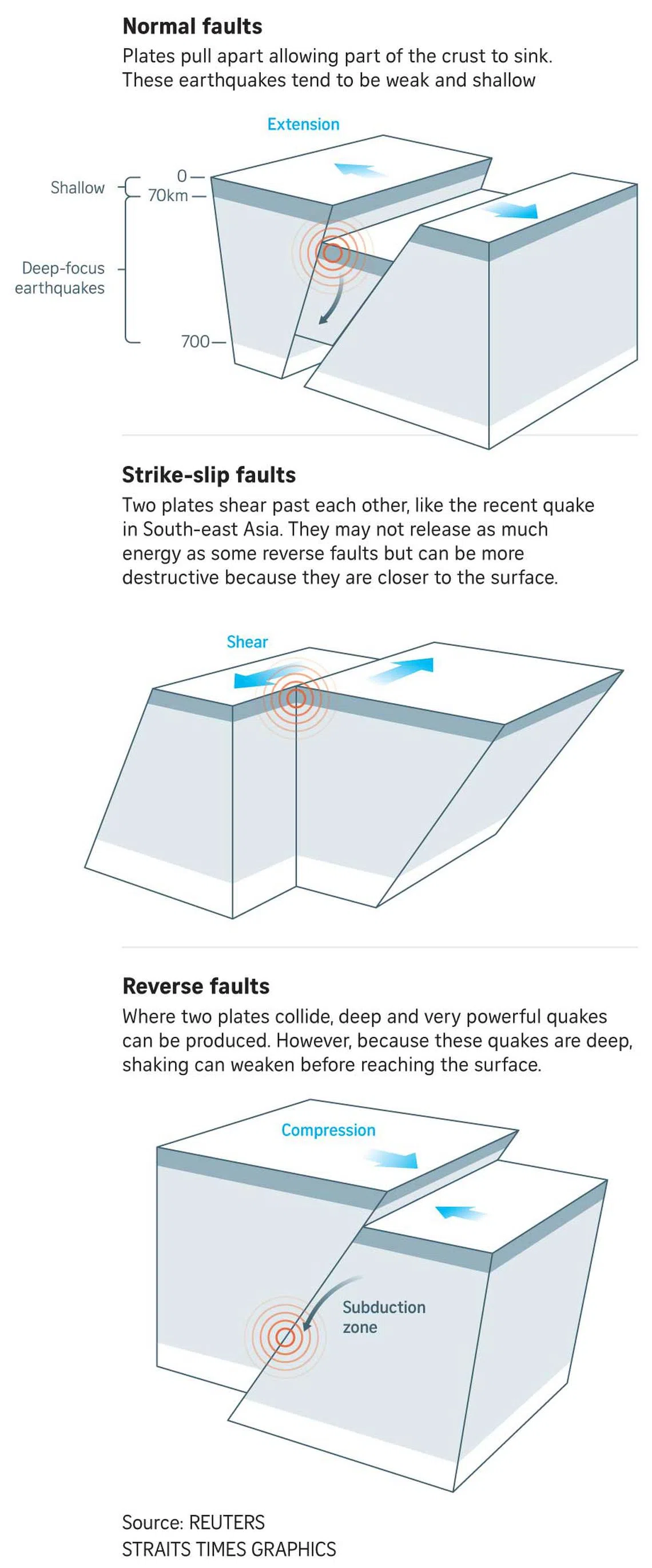Myanmar quake death toll climbs to over 1,600 as international aid starts to arrive
Sign up now: Get insights on Asia's fast-moving developments
Follow topic:
BANGKOK – Foreign rescue teams began flying into Myanmar on March 29 to aid the search for survivors of an earthquake that killed more than 1,600 people in the impoverished South-east Asian nation, crippling critical infrastructure amid a grinding civil war.
The death toll from the major quake in Myanmar had risen to 1,644, the ruling junta said on March 29, with 3,408 people injured.
At least nine people were killed in neighbouring Thailand, where the 7.7-magnitude quake rattled buildings and brought down a skyscraper under construction in the capital Bangkok, trapping 30 people under debris, with 49 missing.
Survivors in Mandalay, Myanmar’s second-biggest city, dug with their bare hands in desperate attempts to save those still trapped, lacking heavy machinery and with the authorities absent.
Mr Htet Min Oo, 25, said that after he was dragged out from under a wall by other residents, he tried to clear the rubble of a crumpled building himself to rescue his grandmother and two uncles – but eventually gave up.
“I don’t know if they are still alive under the debris,” he told Reuters, breaking into tears. “After so long, I don’t think there’s any hope.”
The US Geological Survey’s (USGS) predictive modelling estimated the death toll could exceed 10,000 in Myanmar and that losses could exceed the country’s annual economic output.
A day after making a rare call for international assistance, Myanmar’s junta chief, Senior General Min Aung Hlaing, travelled to hard-hit Mandalay near the epicentre of the quake.
“The chairman of the State Administration Council instructed the authorities to expedite search and rescue efforts and address any urgent needs,” the junta said in a statement on state media, referring to Gen Min Aung Hlaing.
“Search and rescue operations are currently being carried out in the affected areas,” the junta said.
An initial assessment by Myanmar’s opposition National Unity Government (NUG) said at least 2,900 buildings, 30 roads and seven bridges had been damaged by the quake.
“Due to significant damage, Naypyitaw and Mandalay international airports are temporarily closed,” said the NUG, which includes remnants of the elected civilian government ousted by the military in a 2021 coup that triggered the civil war.
The control tower at the airport in Naypyitaw, Myanmar’s purpose-built capital city, collapsed, rendering it inoperable, a person with knowledge of the situation told Reuters.
A Chinese rescue team arrived in Myanmar’s commercial capital of Yangon, hundreds of kilometres from the hard-hit cities of Mandalay and Naypyitaw, where parts of a 1,000-bed hospital were damaged.
Chinese President Xi Jinping spoke by phone with the junta chief, and said Beijing would provide US$13.77 million (S$18.5 million) worth of aid, including tents, blankets and emergency medical kits.
The US, which has a testy relationship with the Myanmar military and has sanctioned its officials, including Gen Min Aung Hlaing, has said it would provide some assistance.
Russia, India, Malaysia and Singapore were sending planeloads of relief supplies and personnel to Myanmar.
“We will continue to monitor the developments and more aid will follow,” said Indian Foreign Minister Subrahmanyam Jaishankar.
Asean, a 10-country grouping that includes Myanmar, said it recognises the urgent need for humanitarian assistance.
“Asean stands ready to support relief and recovery efforts,” the group said in a statement.
South Korea said it would provide an initial US$2 million in humanitarian aid to Myanmar through international organisations.
The quake, which hit around lunchtime on March 28, impacted wide swathes of the country, from the central plains around Mandalay to the hills of Shan, parts of which are not completely under the junta’s control.
Searching Bangkok tower rubble
Ms Susan Hough, a scientist with the USGS’ Earthquake Hazards Programme, told Reuters it was difficult to predict an earthquake’s death toll, for various reasons including timing.
When a quake strikes during the daytime, as it did in Myanmar, “people are awake, they have their wits about them, they are better able to respond”, she said.
In Bangkok, 1,000km from the epicentre, a rescue mission stepped up its efforts on March 29 to find construction workers trapped under the rubble of the collapsed 33-storey tower.
The authorities used excavators, drones and search-and-rescue dogs to try to extricate the 30 people, including at least 15 still showing signs of life.
“We will do everything, we will not give up on saving lives, we will use all resources,” Bangkok Governor Chadchart Sittipunt said at the site.
After the city ground to a halt on March 28, hundreds spent the night in parks, but the situation was improving on March 29, he said.
Ms Waanpetch Panta sat at the site of the collapsed building with her husband, watching the rescue operations and waiting for news of their 18-year-old daughter, who is among the missing.
“I prayed that my daughter was among those taken to the hospital already,” she said. “All I can do is sit and wait like this.” REUTERS



